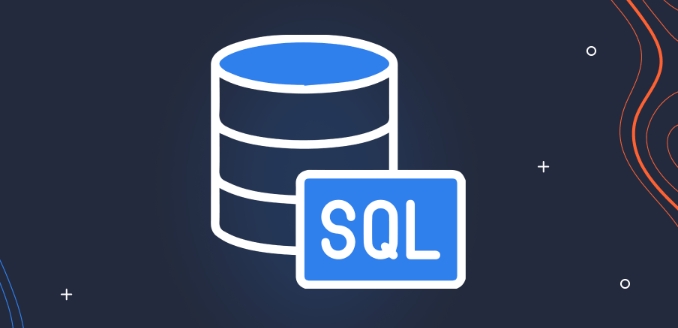SQL snapshots are an efficient means of point-in-time recovery, especially for rapid rollback to a specific point-in-time when misoperation or data is damaged. 1. SQL snapshots are read-only and static database views that record the status of a certain point in time, record data page changes through the sparse file mechanism, which is fast creation speed and low resource utilization. 2. The advantages of using snapshot recovery include fast speed, few resources, no impact on the primary database, and suitable for misoperation of recovery, but cannot replace complete backups. 3. The syntax for creating snapshots is simple, and the recovery is implemented through the RESTORE command. 4. Practical suggestions include creating before critical operations, creating automatically regularly, paying attention to snapshot file growth, and multiple snapshots support multi-point-in-time recovery. 5. Notes include affecting the performance of write operations, snapshot files should be stored separately, restored to the entire database level, and only for use by the same SQL Server instance.

Direct response title: SQL snapshots are an efficient means to achieve point-in-time recovery, especially when misoperation or data corruption can quickly roll back to a specific point-in-time.

What is SQL snapshot?
SQL Snapshot is a read-only, static database view that records the status of the database at a certain point in time. It is not a complete backup, but records changes to the original data page through the sparse file mechanism, so it is fast to create and has low resource utilization.
In point-in-time recovery, snapshots can act as "time machine", allowing you to quickly restore to the data state when you created the snapshot without having to restore the entire database from the backup file.

Why use snapshots for point-in-time recovery?
There are several significant advantages to using snapshots for recovery:
- Fast speed : Snapshot recovery is almost instant than recovery from backup.
- Less resource occupancy : When creating a snapshot, the entire database will not be copied, only changes will be recorded.
- Does not affect the main database : the snapshot is read-only and will not interfere with the operation of the current database.
- Suitable for misoperation recovery : For example, a table is deleted or updated incorrectly, it can be quickly restored through snapshots.
But also be aware that snapshots cannot replace full backups. It depends on the data file of the original database, and if the original data file is corrupted, the snapshot will also fail.

How to create and use SQL snapshots?
The syntax for creating snapshots is relatively simple. Take SQL Server as an example:
CREATE DATABASE YourDatabase_Snapshot
ON
(
NAME = YourDatabase_Data,
FILENAME = 'C:\Snapshots\YourDatabase_Snapshot.ss'
)
AS SNAPSHOT OF YourDatabase;Using snapshot recovery is also straightforward:
RESTORE DATABASE YourDatabase FROM DATABASE_SNAPSHOT = 'YourDatabase_Snapshot';
Several practical suggestions:
- Create snapshots before performing key operations (such as launching new versions, batch data updates).
- Snapshots are created automatically regularly as part of point-in-time protection policies.
- Pay attention to the growth of snapshot files. Although sparse files are small at the beginning, they will become larger as the data changes.
- Snapshots can only be restored to the state they were created and cannot be used to restore to any point in time unless you have multiple snapshots.
Frequently Asked Questions and Notes
Does snapshot affect performance?
This will affect the performance of write operations, because you need to copy the original page first (copy-on-Write when writing).Where to put the snapshot file?
It is recommended to place it on a separate disk or storage path to avoid affecting the main database I/O.Can a single object be restored?
Snapshot recovery is at the entire database level. You cannot restore a table or a stored procedure separately, but you can query the data in the snapshot and then import it into the main database.Can snapshots be used across servers?
No, snapshots can only be used under the same SQL Server instance.
Basically that's it. Snapshots are a lightweight and efficient recovery tool, but you also need to pay attention to the scenarios and limitations when used.
The above is the detailed content of Implementing SQL Snapshots for Point-in-Time Recovery. For more information, please follow other related articles on the PHP Chinese website!

Hot AI Tools

Undress AI Tool
Undress images for free

Undresser.AI Undress
AI-powered app for creating realistic nude photos

AI Clothes Remover
Online AI tool for removing clothes from photos.

Clothoff.io
AI clothes remover

Video Face Swap
Swap faces in any video effortlessly with our completely free AI face swap tool!

Hot Article

Hot Tools

Notepad++7.3.1
Easy-to-use and free code editor

SublimeText3 Chinese version
Chinese version, very easy to use

Zend Studio 13.0.1
Powerful PHP integrated development environment

Dreamweaver CS6
Visual web development tools

SublimeText3 Mac version
God-level code editing software (SublimeText3)
 Defining Database Schemas with SQL CREATE TABLE Statements
Jul 05, 2025 am 01:55 AM
Defining Database Schemas with SQL CREATE TABLE Statements
Jul 05, 2025 am 01:55 AM
In database design, use the CREATETABLE statement to define table structures and constraints to ensure data integrity. 1. Each table needs to specify the field, data type and primary key, such as user_idINTPRIMARYKEY; 2. Add NOTNULL, UNIQUE, DEFAULT and other constraints to improve data consistency, such as emailVARCHAR(255)NOTNULLUNIQUE; 3. Use FOREIGNKEY to establish the relationship between tables, such as orders table references the primary key of the users table through user_id.
 Key Differences Between SQL Functions and Stored Procedures.
Jul 05, 2025 am 01:38 AM
Key Differences Between SQL Functions and Stored Procedures.
Jul 05, 2025 am 01:38 AM
SQLfunctionsandstoredproceduresdifferinpurpose,returnbehavior,callingcontext,andsecurity.1.Functionsreturnasinglevalueortableandareusedforcomputationswithinqueries,whileproceduresperformcomplexoperationsanddatamodifications.2.Functionsmustreturnavalu
 Using SQL LAG and LEAD functions for time-series analysis.
Jul 05, 2025 am 01:34 AM
Using SQL LAG and LEAD functions for time-series analysis.
Jul 05, 2025 am 01:34 AM
LAG and LEAD in SQL are window functions used to compare the current row with the previous row data. 1. LAG (column, offset, default) is used to obtain the data of the offset line before the current line. The default value is 1. If there is no previous line, the default is returned; 2. LEAD (column, offset, default) is used to obtain the subsequent line. They are often used in time series analysis, such as calculating sales changes, user behavior intervals, etc. For example, obtain the sales of the previous day through LAG (sales, 1, 0) and calculate the difference and growth rate; obtain the next visit time through LEAD (visit_date) and calculate the number of days between them in combination with DATEDIFF;
 How to find columns with a specific name in a SQL database?
Jul 07, 2025 am 02:08 AM
How to find columns with a specific name in a SQL database?
Jul 07, 2025 am 02:08 AM
To find columns with specific names in SQL databases, it can be achieved through system information schema or the database comes with its own metadata table. 1. Use INFORMATION_SCHEMA.COLUMNS query is suitable for most SQL databases, such as MySQL, PostgreSQL and SQLServer, and matches through SELECTTABLE_NAME, COLUMN_NAME and combined with WHERECOLUMN_NAMELIKE or =; 2. Specific databases can query system tables or views, such as SQLServer uses sys.columns to combine sys.tables for JOIN query, PostgreSQL can be used through inf
 How to create a user and grant permissions in SQL
Jul 05, 2025 am 01:51 AM
How to create a user and grant permissions in SQL
Jul 05, 2025 am 01:51 AM
Create a user using the CREATEUSER command, for example, MySQL: CREATEUSER'new_user'@'host'IDENTIFIEDBY'password'; PostgreSQL: CREATEUSERnew_userWITHPASSWORD'password'; 2. Grant permission to use the GRANT command, such as GRANTSELECTONdatabase_name.TO'new_user'@'host'; 3. Revoke permission to use the REVOKE command, such as REVOKEDELETEONdatabase_name.FROM'new_user
 What is the SQL LIKE Operator and How Do I Use It Effectively?
Jul 05, 2025 am 01:18 AM
What is the SQL LIKE Operator and How Do I Use It Effectively?
Jul 05, 2025 am 01:18 AM
TheSQLLIKEoperatorisusedforpatternmatchinginSQLqueries,allowingsearchesforspecifiedpatternsincolumns.Ituseswildcardslike'%'forzeroormorecharactersand'_'forasinglecharacter.Here'showtouseiteffectively:1)UseLIKEwithwildcardstofindpatterns,e.g.,'J%'forn
 How to backup and restore a SQL database
Jul 06, 2025 am 01:04 AM
How to backup and restore a SQL database
Jul 06, 2025 am 01:04 AM
Backing up and restoring SQL databases is a key operation to prevent data loss and system failure. 1. Use SSMS to visually back up the database, select complete and differential backup types and set a secure path; 2. Use T-SQL commands to achieve flexible backups, supporting automation and remote execution; 3. Recovering the database can be completed through SSMS or RESTOREDATABASE commands, and use WITHREPLACE and SINGLE_USER modes if necessary; 4. Pay attention to permission configuration, path access, avoid overwriting the production environment and verifying backup integrity. Mastering these methods can effectively ensure data security and business continuity.
 Explain the Distinction Between a SQL Schema and a Database.
Jul 05, 2025 am 01:31 AM
Explain the Distinction Between a SQL Schema and a Database.
Jul 05, 2025 am 01:31 AM
OK, please provide the article content that needs a summary.






